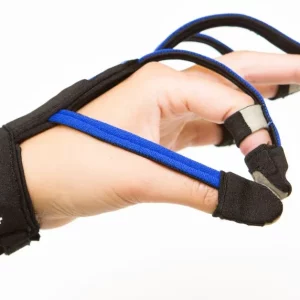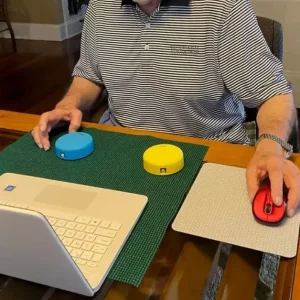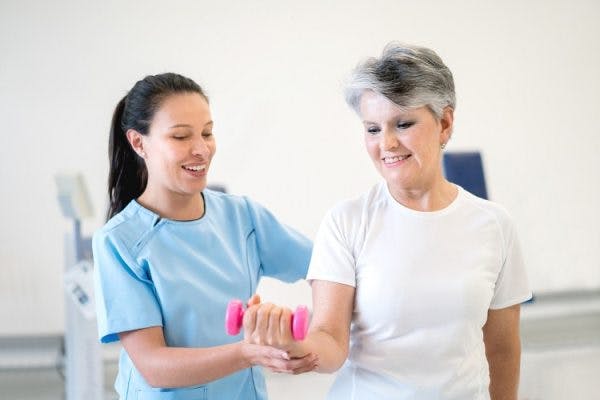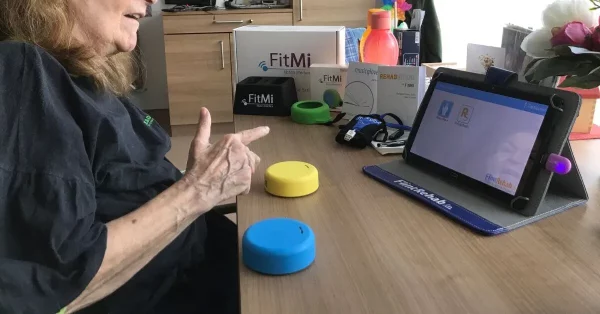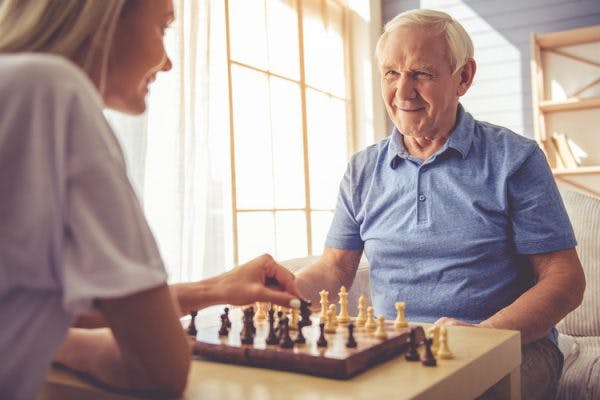Visual impairments are experienced by over half of all stroke survivors. While some visual impairments directly affect ability to move the eyes, others affect the brain’s ability to accurately perceive what the eyes are seeing. Regardless of the specific type of vision loss, practicing eye exercises after stroke may help survivors improve their vision.
Before outlining which types of eye exercises may be most effective, this article will discuss how a stroke may affect one’s vision. Some practical considerations regarding the use of eye exercises after stroke will also be included.
Please feel free to use the links below to jump directly to any section of this article.
- Visual changes that may occur after stroke
- Eye exercises to regain control over the muscles of the eyes
- Visual perceptual exercises
- Practical considerations
How Can a Stroke Impact the Ability to See?
When a stroke occurs, blood flow within the brain is compromised, resulting in damage to the affected areas of the brain. Depending on which areas of the brain are affected, a number of secondary effects may be sustained.
While the occipital lobe is primarily responsible for visual functions, other areas of the brain such as the parietal lobe, cerebellum, and brainstem are also involved in vision. Therefore, when a stroke causes damage to any of these areas, among others, visual changes may occur.
The ability to see involves multiple components, including:
- Oculomotor skills: control over the muscles of the eyes, and
- Visual perceptual skills: the brain’s ability to understand what the eyes are seeing
If one or both of these skills are impacted after stroke, survivors will experience changes in their vision. These changes may range from mild to severe, depending on the area(s) of the brain impacted and the severity of damage.
Conditions affecting oculomotor skills, referred to as eye movement disorders, include nystagmus (rapid and involuntary eye movements), strabismus (eye misalignment), or diplopia (double vision). On the other hand, disorders that may occur when visual perceptual skills are impacted include hemineglect (the inability to perceive the surroundings on one side of the body) and visual agnosia (difficulty recognizing and distinguishing what is being seen).
Practicing eye exercises after stroke can help survivors regain their vision by promoting adaptive rewiring in the brain through a process called neuroplasticity. This can allow healthy areas of the brain to assume control of the affected areas.
Repetitive practice of exercises is the best way to promote adaptive changes within the brain. Although some eye exercises after stroke may feel awkward, they should not be painful. Take a break when necessary. However, remember to resume practicing at a later time for optimal improvements. While a full recovery is not guaranteed, many survivors find that they can at least partially recover their vision.
Eye Exercises After Stroke to Develop Oculomotor Skills
Since there is such a wide variety of vision problems that survivors may experience after stroke, the most effective exercises for one person may not be very helpful for another. Working with vision therapist, optometrist, or other professional who focuses on visual skills is the best way to learn which exercises would be most effective for an individual’s specific needs.
However, there are some generalized eye exercises that may help survivors struggling with impaired oculomotor skills, or difficulty controlling the eye muscles. Survivors experiencing conditions in which oculomotor skills are affected may present with blurry vision, double vision, or difficulty focusing the eyes.
The following list includes some of the most effective eye exercises after stroke for recovering oculomotor control:
1. Directional Tracking
Practicing visual tracking can help retrain the six muscles that control the eye while also improving blood flow and eye health. Start by taking a pencil and holding it about 18 inches from the face at eye level. Then, with the eyes focused on the pencil’s eraser, slowly move it from left to right as far as it can be seen without moving the head.
Return to the center, then move the pencil up and down as far as possible within the field of vision. Again, make sure to avoid moving the head, so that the eye muscles are working rather than the neck muscles. Repeat this 5 times in both directions.
2. Clock Rotations
For those who have mastered directional gazing, consider trying clock rotations. Begin by fixing the gaze straight ahead. Then, picturing a clock in front of the face, look directly up at 12 o’clock with the eyes (without moving the head). Feel a gentle stretch in the eye muscles, holding there for 3-5 seconds before returning to a relaxed forward gaze.
Repeat this process all the way around the clock, looking toward 1 o’clock next, then 2 o’clock and so on. Some survivors find having a caregiver or family member hold a pencil at each point on the clock can help ensure they are shifting their gaze accurately.
3. Near/Far Focusing
This eye exercise is ideal for survivors having trouble with focusing their vision after stroke. Start by holding the finger out about arm’s length away. Breathe in while looking at the tip of the finger, then breathe out while gazing into the distance past the finger.
Switch between focusing on the finger and focusing in the distance a total of 10 times. For those having difficulties with this exercise, consider finding a specific object in the distance to focus on, rather than simply gazing into the distance.
4. “Tromboning”
This exercise also targets visual focus. Starting again with a finger extended an arm’s length away, begin to focus the eyes on the finger. Next, gently bring the finger toward to the face. Breathe in while remaining focused on the finger, bringing it closer and closer.
Then, breathe out and begin to move the finger away. Alternate between extending the finger and bring it closer, like slowly pumping a trombone back and forth. Repeat 10 times.
Want 25 pages of stroke recovery exercises in a PDF? Click here to download our free Stroke Rehab Exercise ebook now (link opens a pop up for uninterrupted reading)
Visual Perceptual Eye Exercises After Stroke
While the previous eye exercises focused on oculomotor skills, some eye exercises after stroke target visual perceptual skills. There are a number of visual perceptual skills that may be affected after stroke, including:
- Visual memory
- Visual closure
- Form constancy
- Visual spatial relationships
- Visual discrimination
- Visual attention
- Visual sequential memory
- Visual figure-ground
Again, working with a vision therapist or other professional who focuses specifically on neurological vison changes is the best way to customize an exercise program for an individual’s specific needs. However, the following list of visual perceptual eye exercises can be a great starting point for survivors experiencing challenges in this area.
5. Word or Letter Searches
Practicing activities such as word searches can be a great way to improve visual perceptual skills. Word searches require visual tracking skills as well as visual discrimination and attention. While word searches can be used in the traditional sense, individuals may also choose to search for a specific letter or for only vowels.
Practicing word searches may also give family members and caregivers a better understanding of any visual field cuts or visual neglect the survivor may be experiencing, as some survivors may completely skip an entire side of the activity. If this occurs, consider highlighting along the edge of the word search that was skipped. Then, encourage the survivor to use this as an anchor, ensuring they look all the way to the highlighted edge when searching each line.
6. Hidden Picture Puzzles
Hidden picture puzzles involve searching for small images that are hidden within a larger picture. This requires numerous visual perceptual skills, including visual memory, form constancy, and figure-ground skills. These puzzles can also be an excellent way to practice different directional tracking techniques, such as searching the image by looking side to side or up and down.
While hidden picture puzzles are usually contained to a sheet of paper, many of the same skills can be generalized on a larger scale to an activity such as a scavenger hunt or game of I-Spy. Finding visual activities that are engaging and motivating can help survivors continue practicing their visual skills on a regular basis, promoting a faster recovery.
7. Peripheral Vision Stimulation
This exercise can help to improve peripheral vision, as well as increase understanding of visual spatial relationships. Ask a family member or caregiver to hold two pencils, one on each side of the survivor’s face (or at the far sides of their visual field).
Look straight ahead and make sure that both of the pencils can be seen using the peripheral vision. Then, ask the caregiver to move one pencil slightly closer and one slightly further away, and guess which pencil is closest. Repeat this 10 times.
8. Mazes and Visual Tracing
Practicing mazes can also help survivors enhance their brain’s ability to process different visual spatial relationships. They can also challenge individuals with hemineglect to improve their visual attention on their affected side.
For a challenge, survivors may try to complete large, relatively simple mazes using only their eyes. Alternatively, visually tracing lines or picture outlines can be a great activity to exercise the eyes after stroke and improve both visual perceptual and oculomotor skills.
9. Computer Games
Individuals looking for more engaging activities involving eye exercises after stroke enjoy practicing online vision games, such as those from Eye Can Learn. This free site includes various activities, organized by skill, that can improve both oculomotor and visual perceptual skills. While the activities are geared toward kids, they can also be more motivating for adults than programs involving rote eye exercises after stroke.
Practical Considerations Regarding Vision After Stroke
Many survivors may feel that their eyes become fatigued after practicing these exercises. A dull ache as well as mental fatigue may be expected, as both the brain and the eyes may be working on regaining lost skills. Taking a break may help with this.
However, these exercises should not result in sharp eye pain. Therefore, if this occurs, consult a vision therapist or other medical professional, as this may indicate more complex medical issues that deserve attention.
While each of the above eye exercises after stroke may help to improve various skills needed for vision, it is often best to consult a vision therapist, optometrist, or other professional focused on vision. They can provide more information regarding precisely which visual skills have been affected, as well as individualized recommendations on how to restore these skills.
Furthermore, although practicing eye exercises after stroke may help improve vision, some individuals may also benefit from other treatments, such as prism glasses or eye patching. Therefore, it is often best to discuss which treatments may be most effective with a professional who specializes in vision.
Understanding Eye Exercises After Stroke
Because vision problems are common effects of stroke, many survivors may benefit from practicing eye exercises after stroke to restore their vision. These exercises may target various visual skills, including oculomotor and visual perceptual skills.
Consistently practicing eye exercises after stroke can spark neuroplasticity, or adaptive brain rewiring. This process can allow healthy areas of the brain to take over affected functions, promoting recovery. While discussing specific concerns regarding vision with a professional is recommended, the eye exercises in this article can help survivors get a great start on regaining their sight after stroke.



